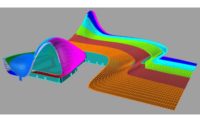The Link Between Designing and Creating
Talking to Machines












Throughout history, to understand the complexities of buildings, models have always been made. For centuries, these were physical scale models that allowed a close examination of the proposed structure. More recently digital models perform the same function. These not only allows stakeholders to comprehend the project but also provide the ability to ensure that crucial decisions are based on the fullest and most detailed information available.
By committing designs and associated information and data to digitalisation it is possible to achieve total quality assurance for each component of the building, and of the entire finished entity. This occurs because by designing and then manufacturing components digitally, any technical, structural and aesthetic issues can be resolved in advance of physical work commencing.
This is not news to engineers and architects, who are often highly digitised. But the digital chain is often broken between building designers and contractors. However, when links are strengthened through the whole supply chain, the results are spectacular.
Leading the World from Morocco
As part of the programme of cultural development in Morocco, and inspired by the Bouregreg River, the dramatic sculptural form of the Grand Théâtre de Rabat in Morocco incorporates an 1800 seat theatre, a 7000-seat amphitheatre and a smaller specialised performance space. Clever use of GRC panels meant the fluid design envisaged by architect Zaha Hadid was successfully interpreted, resulting in the addition of a cultural venue of the highest standards for the city of Rabat in Morocco.
The main envelope system for the Grand Théâtre project is based on an opaque glass-fibre-reinforced concrete (GRC) rainscreen cladding, fixed to the primary structure, which is a mix of reinforced concrete and steel. The main driving parameter for the design of the GRC system was the required 60-year life-span of the envelope system. This required the use of monolithic GRC panels, up to 4 × 2m in size, which did not require the conventional steel backing frame to be cast-in underneath the panel.
Computational Fluid Dynamics (CFD) analysis for cladding pressures was undertaken and subsequently validated by a series of wind tunnel tests. This analysis allowed the use of realistic values for wind loads, which drive stress and deflection analysis of the panels while taking into account the effects of the geometry of the building.
Structural calculations for each component were undertaken for each project-specific configuration using finite element modelling and scripting to automate the structural analysis process for all panels. The design of the adjustable steel fixing bracket was conceived so that only one fixing type was used across the whole project, which would minimise cost.
Physical tests were designed to validate a single design for the connection between GRC panels and steel fixings, which could be used safely across the entire project.
This spectacular building produced at a very reasonable cost is an exemplar of how early stage deep analysis and thorough testing before the tender stage delivers a guaranteed result. It was important in this project to ensure that local fabricators and contractors were deployed. Digital simulation of all processes resolved any potential problems prior to physical work commencing and 3D printed GRC panels were thoroughly tested to validate computational analysis.
Flexible Decision Making
By considering and studying everything in advance of physical work it is possible to understand the true implications of project choices and decisions. Digitising projects enables flexibility because general properties can be analysed in relation to fine details. This means that decisions over materials can be made with a full understanding of their cost, aesthetics and construction technique implications.
Working this way means material parameters can be better understood and designers can go beyond simply claiming that a certain component or finish is better. They can prove it in terms of material or fabrication cost in addition to visual considerations.
Using digital models to explain building techniques to contractors and work with them to develop and optimise strategies can be done at an early stage to improve outcomes.
Adding these types of services to the production of buildings is new for many contractors but those that that we work with discover that the application of engineering design becomes their ‘service element’ and allows them to present fully validated solutions to their customers. This in turn lets them win more contracts in the confidence that they can be fulfilled on time and to budget.
Code
Computer code is the shorthand that delivers the robust instructions that solve complex engineering problems. Computer code also provides the living user manual to operate the building for decades to come. Every design, test and action related to a building’s genesis, construction and maintenance is captured. This record becomes available to anyone who needs to engage with the project.
One use of this data at the Grand Theatre de Rabat involved using a Total Station to pinpoint component locations and their fixing points with a laser. The coordinates were fed to the Total Station from the optimised engineering design and, by following this simple guide, costly mistakes and misalignments totally avoided.
Across the globe in Australia the advanced structure that forms the facade of, Botanica, an innovatively conceptualised residential block in northern Queensland could have been made from either steel of concrete. By simulating the design and fabrication of both options the cost was calculated with a high degree of precision and concrete was selected. In the past, this decision would have put more emphasis on material cost but because every aspect was considered in advance the true cost was revealed. This strategy assesses and addresses risks in new ways that seek to define all parameters so that risk can more easily be understood, calculated and managed and costs and schedules guaranteed.
Accelerating Productivity
Deploying these techniques means that amazing buildings can be delivered at ordinary prices. Designs can evolve smoothly to suit all parties and various design options considered and proven.
An example of this is the KCTV Tower in Istanbul where early stage investment in design engineering has paid a massive dividend at the current building stage. All the big decisions have been made and the building is progressing as predicted with pre-made components that are exact representations of their digital equivalents. This is very different to many projects where late stage changes contribute to dysfunctionality and defects.
Top ten tips for smooth building delivery:
- Invest in early stage problem solving to avoid late stage issues
- Use engineering as a service that seamlessly joins construction disciplines
- Break down the barriers between thinking and doing
- Apply rigour to design and management processes – keep looking for what’s been missed
- Use data to introduce flexibility into decision making
- Take problem solving back to first principles – conformity is dangerous
- Connect contractors and fabricators with designers and clients through shared data
- Deploy technology that allows everyone to understand their project role and responsibility
- Think about production machinery at the earliest stages of the project
- Improve processes through learning
Looking for a reprint of this article?
From high-res PDFs to custom plaques, order your copy today!






.jpg?height=200&t=1639747170&width=200)






